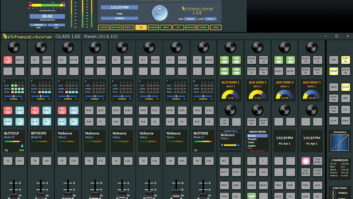An essential habit in audio recording is Critical Listening, the professional practice of listening in a systematic and careful way to audio in production in order to make it sound better for others, including producers and end users.
In this column I want to discuss an interesting myth that has rattled around the industry for years (I’ve certainly contributed to the rattling): “The Myth of Crummy Speakers.”

For years, audio professionals have used Avantone Mixcubes to determine audio quality on small speakers.
That myth is based on the assumption that our end users all or mostly listen on crummy speakers. Therefore, we reason, we need to do our production work on crummy speakers as well, so that (a) we can hear all the crumminess that our end-users are subjected to, and (b) we can try to “make our audio sound good” on our crummy speakers in the hope that it will then also sound good on their crummy speakers as well.
There is even a brand of speakers that has been widely used as a reference for “crummy speakers”: the Auratone (and a successor, the Avantone). These are small cubes with a single 5-inch driver and a retail price of approximately $100/speaker. I have a pair standing by in my studio (that I haven’t actually used since 2003!).
A LACK OF EXCELLENCE
The first thing to note, when we start to consider this, is that not all crumminess sounds the same. In fact, crumminess is inherently diverse, so that the crummier things are, the more different ways those crumminesses manifest themselves. Crumminess is, in fact, a massive random accumulation of errors in design, manufacture and usage.
Such crumminess is usually a function of some or all of the following: inappropriate design goals, inadequate design specifications and standards, inadequate budgets, and indifference to outcomes.
What this all means is that crummy speakers are much less likely to sound alike than excellent speakers, and we can rest assured that whatever crumminess we choose to use will probably sound different, perhaps much different, than most of our end-users’ crummy speakers.
The problem this presents to us is that we cannot count on our crumminess resembling the range of crumminesses that our listeners must endure.
Thought about this way, it is actually fairly obvious.
THE IMPORTANCE OF SPEAKER TOPOLOGY
There is more to this, however. Loudspeakers are complex and imperfect devices that utilize a small family of topologies based on the number of drivers included in the design.
At the same time, the number of drivers determines something fundamental about the bandwidth (or frequency spectrum) of the loudspeaker, which in turn determines much about “how it sounds.”
So a single-driver speaker, such as the Auratone, can only have a quite limited bandwidth. The 5-inch driver of the Auratone is too small to generate long wavelengths (low frequencies) and too large to generate very short wavelengths (high frequencies). As a result, it has easily observed audible limitations.
And here’s where that myth has some validity. The Auratone will, in many respects, resemble all similar single-driver loudspeakers of approximately the same size (say, from 4 inch to 7 inch). Such speakers show up in very cheap cars and trucks, as well as many cheaper boom-boxes, table radios, cheap TVs and the like.
By the same token, a two-way speaker, with a tweeter and a woofer mounted in a small box (a so-called “bookshelf” speaker, typically), will have much in common with most of its topographical siblings. The tweeter will usually be designed to cover the top three octaves (say, 2.5 kHz to 20 kHz, sort of), and will be crossed over to a woofer designed to cover perhaps 4 octaves (which is really a stretch) from, say, 125 Hz to 2 kHz.
There will often be an audible dip in response between the woofer and the tweeter, and the lower bass will also be comparatively weak. Such behavior will be characteristic of most such small two-way “bookshelf” speakers.
WHAT I’VE FOUND
Over the years that I’ve struggled with this, I’ve tried a lot of things. My neighbor, mentor and ultra-engineer, Tom Bates, makes the case that “you can’t quit mixing until your mix sounds good on all of the available speakers, not just some of them.” So I’ve tried going through an exhaustive auditioning process, including listening to my production work (both mixing and mastering) on multiple speaker systems in the studio, on a boom box in the kitchen, a home theatre system in the living room (complete with Dolby Pro Logic) and several car systems (where I audition while parked, driving around fast, driving around slow, top up, top down, etc.).
I’ve also asked some other mix and mastering engineers what they do.
Little by little, especially after the quality of my monitors improved because of a Bang & Olufsen project I’ve been involved with, I’ve been able to set this obsessive range of testing aside. I’ve done this both because it can be exhausting (and expensive for the client!) and because as I got more and more grooved into my monitors, I found I had fewer and fewer surprises when I checked my work on other systems. I came to “know,” beforehand, what, for instance, the system in car #2, at speed, with the top down, was going to sound like.
WHAT DOES IT ALL MEAN?
My advice to you is this: Do your critical listening and production work on the best speakers you can obtain. Then check your work on speakers of various appropriate topologies (i.e. boomboxes, TVs and bookshelf speakers) of the best quality you can obtain. That should enable you to get a reasonably clear idea of “what it will sound like” for those topologies, in an idealized sort of way, with as few extra errors as possible. Your speakers may not sound as crummy as your end users’ speakers do, but you’ll be able to guess more accurately at the general range of crumminess that they are encountering.
Some years ago, I took part in a loudspeaker evaluation project that directly addressed these issues. You can read about that adventure on my website www.moultonlabs.com. It’s actually fairly interesting, if you’re curious about these things.
Dave Moulton is an audio engineer and producer, author, composer, educator and acoustician. He operates Moulton Laboratories/Digital Media Services in Groton, Mass. This article was first published in TV Technology magazine.












